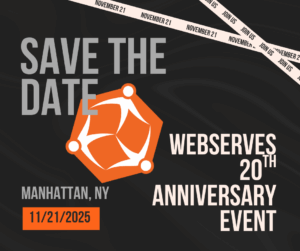By: Juliana Reiner
If your organization already has a website up and running, you’ve achieved a vital milestone; a significant number of people will completely disregard a business that lacks one. However, crafting an impactful website takes a considerate amount of thoughtful design that stems from an understanding of how people think and interact with the web. To ensure your website is truly effective in engaging users, ask yourself the following questions.
Question 1: Is our organization’s mission immediately clear?
New visitors to your site come asking the same basic question: Who are you?
First impressions are formed in just a fraction of a second, so clearly highlighting your mission and the impact of your work right away is a key factor in a user’s desire to further invest in the organization.
To ensure your mission is coherent and compelling, consider the following key strategies:
- Include a short clear tagline speaking to your mission and values that leaves little room for ambiguity or confusion.
- Make sure your imagery actually reflects the work you do, steering clear of generic stock photos that do not contribute to your story.
- Include real specific examples of projects your organization has worked on and their impact to help tie your mission to tangible outcomes. This will help drive home exactly what you have achieved and its importance.
Question 2: Does our website evoke the intended emotional response?
Understanding the mission is just the first step in ensuring your website makes a lasting impression. Designing to convey some sort of emotion – whether it be empathy, surprise, warmth, or even outrage – is pivotal to how users engage with and perceive an organization. An emotional response is not necessarily overt; nobody is expecting to be left in hysterics or moved to tears by a web design. However, certain design tactics convey more emotion than others, creating a personal tie between the user and your cause.
Consider a food pantry’s website. Which of the following taglines seems more compelling?
- Reducing hunger one meal at a time
- Over 14 million children will go to bed hungry tonight. We won’t sleep until it’s zero.
While both taglines may speak to the organization’s mission, option 1 is more declarative and straightforward. Option 2 provides a greater sense of urgency by grounding the mission in real statistics and emphasizing the organization’s commitment to the cause.
Additional examples of emotional design may include highlighting your impact, utilizing images that convey the importance of your mission, incorporating statistics to create an understanding of your work’s necessity, and even sharing real stories from people whose lives you’ve impacted.
Question 3: Is our call to action actually calling people?
Whether it’s Donate Now! or Click to Learn More, a call to action (CTA) is your prompt for users to complete a specific action. The more thoughtfully you design and place this, the more likely users are to follow through. Here are some strategies to help you craft an effective CTA.
- Make it visually distinct. CTAs are frequently in the form of clickable buttons on a website. Make it contrast from the surrounding design elements through the use of color, size, and placement.
- Use direct and simple wording, instructing the user on exactly what to do without using internal verbiage that may lead to confusion.
- Place the primary CTA above the fold. In other words, make sure locating it does not require any scrolling.
Question 4: Does our website come across as trustworthy?
Whether it concerns data privacy, misinformation, or online scams, people are increasingly cautious about the websites they visit. To show that your organization is credible and trustworthy, consider the following design features.
- An About Us page with clear smiling photos of your team members provides a glimpse into the faces behind the mission. This helps humanize your organization and yields a sense of connection and transparency.
- An up-to-date clean design communicates a sense of professionalism and competence. An organized modern layout and consistent branding is essential to conveying your organization’s legitimacy.
- Just as product reviews help sway a user toward making a purchase, including snippets of testimonials on your website – whether it be from clients, communities, or others who have benefitted from your work – provides social evidence of the organization’s credibility.
Question 5: Do we produce quality written content?
Your written content is your voice. Articles, headers, or blog posts riddled with grammatical errors and inconsistencies often read as unprofessional, and the brand’s identity comes across as ambiguous and confusing. Producing thoroughly edited content that sticks to a tone true to your organization is another way to make sure you come across as credible and professional, furthering user engagement.



